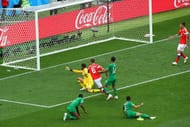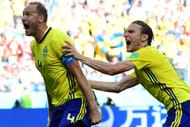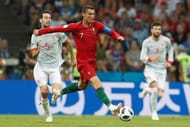The group stages of World Cup 2018 threw up a number of surprises.
Chief among these was Germany’s premature exit from the competition, the defending champions knocked out at the group stage for the first time in 80 years, having failed to impressed. But for every big failure, there was a tail of success, such as that of Japan’s progression to the knockout rounds, however controversially.
What there has not been, however, in Russia, is a significant tactical revolution. Teams are, by and large, sticking to tried and tested formations, although it is notable that there has been a move away from three-man defences, which have been used extensively at the top level over the course of the last campaign.
Over the course of the tournament, there has been a move away from using ‘false 9’, which the likes of France and Germany bringing back a target man for their second games.
With all this in mind, here are the five formations that have been most used so far in Russia – with some of those that may gain in importance thrown in.
3-4-3
Few teams have actually deployed a system using three men at the back at the World Cup yet, despite it being a system that has grown in popularity in the Champions League and at the top level in Europe over the course of the last couple of years.
However, it is worth noting that a couple of the favourites have – and it has had very different effects for them.
Belgium have favoured a variant on this formation, playing with Dries Mertens and Eden Hazard sitting in behind Romelu Luaku and using it as a dynamic, attacking formation, from which they have successfully managed to get the best from the myriad of attacking players they have at their disposal. They might not have faced a serious test yet, but their opening couple of matches have, at least, been promising.
On the flip side of the coin, however, is Argentine. They went with a 3-4-3 formation in their ill-fated group match against Croatia, in which they suffered a stunning 3-0 defeat that meant they faced a serious challenge to qualify for the latter stages of the event.
It is a formation that may be used as an alternative system for several sides, too. Uruguay went with a three-man defence in their final group match against Russia in order to combat the strength of the home side down the flanks and allow them to play in a more vertical fashion, with fewer needless passes in the midfield. They may revert back to 4-4-2 in the knockout rounds, however.
Already it has proven a useful system to have up your sleeve – if implemented effectively.
4-1-4-1

The longer the tournament going on, the less chance there is of spotting a 4-1-4-1 system, which has been the go-to formation of some of the weaker nations when they have faced bigger fish so far.
It was showcased in the opening match of the tournament, when Saudi Arabia tried to stifle Russia playing in this manner, though the 5-0 defeat they suffered in that encounter showed just how ineffective they were at preventing their hosts from playing.
Using this formation should guarantee a degree of stability through the centre of the pitch, where the ‘1’ can act as a utility defensive player, able to cover where most required at any given moment. Should the midfield be breached, he should be able to sweep up and cover the danger. Equally, he can give the more advanced midfielders greater license to get forward and support the lone forward by making late runs into the box.
It is primarily a set up favoured by underdogs, but as the level of competition grows more even as the tournament progresses, it is liable to be used with increasing frequency.
So far, none of the teams playing in this manner in Russia have managed to score a victory.
4-3-3

Typically a formation used by teams looking get rapidly onto the attack, the 4-3-3 system has most notably been used by Brazil over the course of Russia 2018 thus far.
The Selecao play the system with three outright forwards – Neymar, Gabriel Jesus and Willian – and are supported by a midfield that has a dynamic feel to it. While some sides may use three negative players in this area, Brazil are expansive in the manner they play, with Philippe Coutinho having slotted into a role here perfectly.
However, with Neymar notably reticent to track back at times, they are not completely gung-ho in their approach and have deployed a couple of more negative players alongside such attacking talents. Casemiro is the most destructive player in this sector, with Paulinho adding energy.
So far, it has worked smoothly for them, though that is little surprise as it is an identity that head coach Tite has worked hard to impose on his team throughout qualifying. They hope it is the one that can lead them to more world glory.
Brazil are the side very much leading the way with this formation, although it may be that others eventually follow suit. France, for example, are one side that could use this formation, with head coach Didier Deschamps still tinkering with his side, having used a 4-3-1-2 in their opening match of the tournament, with Antoine Griezmann operating as a No.10 – a slight variant on Brazil’s system, with the way they played it rather narrower.
In both, width comes from the full-backs, as the formation is most effective when they are attacking.
4-4-2

The 4-4-2 system has been the second most frequently used formation in the opening matches of the World Cup, proving that a classic never goes out of fashion, even if its use has declined significantly over the course of the decade.
For international football teams, it offers a very basic set up that all their players are generally well versed in playing in. Given that these sides often have precious little time to get to know one another, that is an important facet for coaches plotting how to make best use of a limited resource.
It is a formation that offers balance all over the park, with a basic four-man defensive structure and two forwards. Of course, the midfield is generally where the variation in this system can take place. Traditionally, two wide attacking players are used, although the set up can be made much more defensive by deploying two more central midfielders.
Sweden nearly used the formation to great success against Germany but as they tired at the end of the game they were caught out. Nevertheless, they maintained their predictable but effective tactics for their following match against Mexico and ran out 3-0 winners, claiming the group in the process.
Senegal, meanwhile, went 4-4-2 when they stunned Poland in their opening match of the competition. When they switched back to their classic 4-3-3 against Japan, they were only able to score a draw and were eventually eliminated by the Asian side on the basis of fair play.
4-2-3-1

By far and away the most prolific formation at World Cup 2018 has been the 4-2-3-1 formation, which has been deployed by more than half the teams that have taken the field so far in Russia.
One of the chief reasons for this is that it is an immensely versatile system, able to perform a number of different functions in a fluid framework. Consequently, the teams who use this system can do so in many different ways.
What has emerged over the course of the tournament, at least from a couple of the big European sides, is a move away from a ‘false 9’ towards a more traditional center forward capable of playing with his back to goal. France favour this formation with Olivier Giroud, while Germany used it as their system of choice when in crisis mode against both Mexico and Sweden, throwing Mario Gomez off the bench.
If a more mobile focal point is used, however, it simply increases the versatility of the formation and can make it difficult for opposing defenders to decide who to pick up and when. Used in this manner, the whole of the front four can potentially rotate.
The use of the wide players is also important in determining the character of this particular formation. Portugal have deployed it in a very aggressive manner by using both Cristiano Ronaldo and Ricardo Quaresma, but equally harder working more defensive players can be used to provide greater solidarity for a team.
It is this versatility that has made it such a popular formation.
